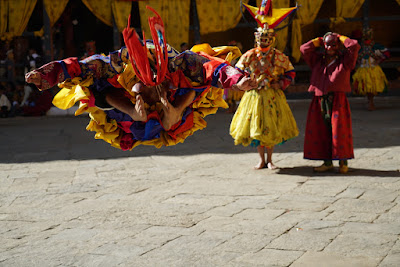Jumping Monks at Holy Festivals
I timed my trip to Bhutan to coincide with one of the country's annual tshechu - religious festivals with masked dances. For the past three days I have been reaping the fruit of my timing and improving my Buddhist vibes while I'm at it at Trongsa dzong.
Dzongs are former fortresses converted to monastic and administrative use (usually one half each). And Trongsa dzong is one of Bhutan's largest and longest, boasting not the usual two or three, but four couryards. The festival took place in the main courtyard on the monastic side. The older half of the dzong was build around 1540, and the "new" part where the festival took place in the 1640's. And the place is drop dead georgeous!Tshechu are a big deal here. Locals try to get off work to attend, market stalls pop up outside the dzong and everyone wears their best and finest gho and kira (men's and women's traditional dresses). Dress code is very strict for the locals. My driver Kinley couldn't get in to the dzong to take a peek at the festivities, since he didn't have the traditional white shawl - the gho equivalent to a tie - with him.
Having managed to bluff my own way into the dzong wearing a fake kira (an Indonesian sarong wrapped over my trousers), I have spent a thrilling two and a bit days enjoying the show. And what a show it has been!
The performances fall into three categories: there are the non-religious traditional songs by local women and old hunting dances by local men, then there are folklore stories told by masked dancing (performers a mix of monks and locals) - more on these at a later date - and finally the real core of the festival and subject of this posting, the religious masked dances performed by monks.
Most of the religious dances portray some god or another defeating demons by performing dances and chanting tantric mantra, which draw out the demon to vanquish him. But the dances also draw out negative energy from the watching crowds - so also the audience benefits from seeing the performance. And it seems to work for me, since I don't feel very negative right now!
Sometimes the demon can be hiding under the skin of a human - as portrayed in the photo below, where a god (or some such forefighter of Buddhism) is attacking the demon (lurking under the spread out human skin) from East, South, West and North to be sure to defeat the bad vibes from all directions.
The gods take on very wrathful appearances to defeat demons. For example, the second Buddha, Guru Rinpoche, who lived in the 8th Century and is much revered in Bhutan, had as many as eight different forms he could assume as the situation demanded:
Gentle forms for scholarly tasks and peaceful duties,
warlike forms for vanquishing demons,
and of course his real form - as seen below accompanied by his two concubines.
It lays a heavy burden on a monk to take on the role of a deity or even the form of the second Buddha himself. For example the natural form of the second Buddha is performed by a very senior monks - often the vice abbot or even the abbot himself.
All the masks are ancient and venerated. For example the skirt of this angel is covered by a lacy kind of apron made out of carved bone, which is many centuries old.
The tshechu is one of the highlights of the year for the whole community - also for the monks, for whom it is a refreshing break from normal monastic life and duties. The monks practice the dances and chants very thoroughly and the practice pays off. I am totally amazed at the agility of some of the monks who perform a specific hop, where the feet must touch the forehead of the performer in mid air. And this with bare feet on a stone surface.
Respect brothers, respect!
















Comments